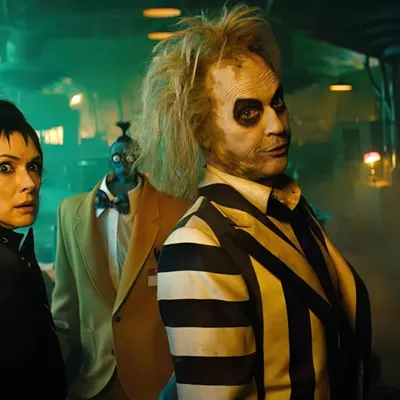A bracing reminder of the power she brings to the screen,
Angelina Jolie delivers a deeply moving performance in Pablo Larrain’s Maria,
the director’s third biopic focused on a significant female figure of the 20th century. Much like Jackie and Spencer, this feature examines the withering
effects of being consistently in the spotlight. Constant petty criticisms
eventually take their toll, leaving
these strong women’s self-esteem in tatters. Yet, through all they endure,
there’s a sense of pride and strength in them that never falters, which is
where Jolie excels, providing the character a sense of defiance she held to
fiercely to the end.
Structured much like Citizen Kane, the film opens on
the afternoon of Sept. 16, 1977, the day Maria Callas was found dead in her
Parisian apartment at the age of 53. We are then treated to a montage of scenes
from her life, composed mostly of her triumphs on stage as well as public
appearances with her partner, Aristotle Onassis. These are moments of
contentment and, one senses, acceptance for the Greek soprano.
Yet once this is over, Lorrain pulls back the curtain to
expose the singer’s arduous life, one beset by poverty and neglect early on,
self-doubt and illness later. To be sure, there was no one more famous or influential
in the world of opera, standing like a Colossus among her peers during the
mid-20th century, yet it was a status that came at a great personal
cost.
As Callas contemplates a comeback, making trips to the Paris
Opera House to meet a confidante who assesses her, she takes a steady number of
sedatives to ease her nerves, which prompts a series of hallucinations. She sees
a reporter (Kodi Smit-McPhee) who questions her about her life for a supposed
documentary, which then elicits memories that show the abuse inflicted on her by her
mother, her rise to fame and her tumultuous relationship with Onassis (Haluk
Bilginer), as well as the onset of the health issues that would plague her for
the last decade of her life.
The structure of the film allows Jolie to showcase not only
her considerable acting talents but her heretofore unheard singing as well.
Having mastered the necessary breathing patterns and vocal inflections, she is
completely convincing when she’s required to sing, the illusion made complete
by using a combination of her and Callas’ voices. In taking this approach
there’s never a sense that lip-synching is at play, the actress selling these
moments with a sense of utter conviction.
Kudos must be paid to Pierfrancesco Favino and Alba
Rohrwacher, who portray Callas’ faithful servants Ferruccio and Bruna. The
actors’ sincere performances help humanize the singer, their care and sympathy
for her providing a vicarious avenue for the viewer to do the same. These two
veterans play wonderfully off one another, while Favino’s scenes with Jolie, in
which they lob subtle barbs at one another, are highlights.
Having been introduced to opera at an early age by his
mother, this is a passion project for Larrain, who uses every tool at his
disposal in making this sympathetic portrait. He uses a wide variety of film
stock and digital settings to create a variety of different looks, a grainy
aesthetic used for the false documentary being shot, one of crisp clarity for
the present and so on. That this never
proves distracting is credit to the consistency in his approach and the
engaging nature of Steven Knight’s screenplay.
Yet, in the end, so much of the success of the film rests on
Jolie’s shoulders and she responds with an intensity that’s been absent in her
performances for quite some time. Though at first glance her stoic approach may
seem simplistic, it’s part of a finely nuanced approach, her seeming
haughtiness but a fragile defense in face of unrelenting scrutiny. As a result,
the moments in which this façade cracks are the ones where Maria’s tragedy
is powerfully driven home.


















